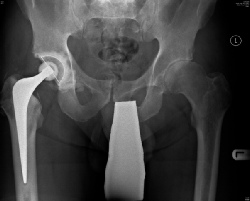Total Hip replacement (THR) remains one of the most successful orthopaedic operations. It is primarily used to treat osteoarthritis of the hip, but can be used to treat fractures of the hip. Most patients who under go this procedure have significant osteoarthritis (wear and tear) of the hip joint which has caused them pain and disability.
The Hip joint is a simple Ball and socket joint at the top of the thigh bone (femur).
Hip replacement involves removal of the ball and replacement with artificial components.
These parts reproduce the natural motion of the hip joint. The components can be
fixed either with cement or without. As a major surgical procedure, there are some
risks associated, clots in the leg and the lungs, dislocation of the hip, infection
and long-
thigh bone (femur).
Hip replacement involves removal of the ball and replacement with artificial components.
These parts reproduce the natural motion of the hip joint. The components can be
fixed either with cement or without. As a major surgical procedure, there are some
risks associated, clots in the leg and the lungs, dislocation of the hip, infection
and long-
At least 50,000 hip replacements are carried out each year in Britain, usually on adults aged over 65. Women are more likely to need a hip replacement than men.
The outlook for a hip replacement is generally considered to be good. Hip replacements
currently last about 20-
However, it is a major operation with a fairly long recovery period. Associated problems include wear and tear of the prosthesis in people who are more active, and the device dislocating or loosening.
| Personal Details |
| Orthopaedic Surgical Team |
| Personal Results |
| Background Information |
| Sports Injury |
| Arthritis |
| Surgical Guides |
| Pre Operative Guides |
| Post Operative Guides |
| Alexandra Hospital |
